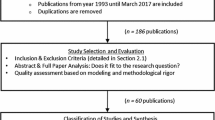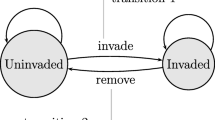Abstract
In this paper, we formulate and analyse a long-term multi-objective dynamic model for controlling invasive species. This optimization framework is then applied to the case of buffelgrass control in the Arizona desert. The proposed model simultaneously optimizes three objectives corresponding to three different valued and threatened resources including saguaros (a native cactus species), buildings and vegetation. The model is used to decide the optimal allocation of labour to these resources to control the population of the species in a multi-period planning horizon. The computational method to solve this problem is based on multi-objective integer programming.













Similar content being viewed by others
References
Betancourt JL (2007). From fireproof desert to flammable grassland: buffelgrass invasion in the Sonoran Desert. Proceedings of the American Geophysical Union, 2007 Fall Meeting.
Bowers JE, Bean TM and Turner RM (2006). Two decades of change and distribution of exotic plants at the desert laboratory, Tucson, Arizona. Madroño 53 (3): 252–263.
Burnett K, Kaiser B and Roumasset J (2007). Economic lessons from control efforts for an invasive species: Miconia calvescens in Hawaii. Journal of Forest Economics 13 (2–3): 151–167.
Burquez-Montijo A, Miller ME and Martinez-Yrizar A (2002). Mexican grasslands, thornscrub, and the transformation of the Sonoran Desert by invasive exotic buffelgrass (Pennisetum ciliare). In Tellman B (ed). Invasive Exotic Species in the Sonoran Region. The University of Arizona Press and the Arizona-Sonora Desert Museum: Tucson, pp 126–146.
Büyüktahtakın İE, Zhuo F, Olsson A, Frisvold G and Szidarovszky F (2010). Positive Analysis of Invasive Species Control as a Dynamic Spatial Process, In 2010 Annual Meeting, July 25–27, 2010, Denver, Colorado (No. 61753), Agricultural and Applied Economics Association.
Büyüktahtakın İE, Zhuo F, Olsson A, Frisvold G and Szidarovszky F (2011). A dynamic model of controlling invasive species. Computers and Mathematics with Applications 62 (9): 3326–3333.
Cacho OJ, Wise RM, Hester SM and Sinden JA (2008). Bioeconomic modeling for control of weeds in natural environments. Ecological Economics 65 (3): 559–568.
Clark C (1990). Mathematical Bioeconomics: The Optimal Management of Renewable Resources. 2nd edn. Wiley-Interscience: Hoboken, NJ.
Clarke PJ, Latz PK and Albrecht DE (2005). Long-term changes in semi-arid vegetation: invasion of an exotic perennial grass has larger effects than rainfall variability. Journal of Vegetation Science 16 (2): 237–248.
Costello C, Springborn M, McAusland C and Slow A (2007). Unintended biological invasions: does risk vary by trading partner? Journal of Environmental Economics and Management 54 (3): 262–276.
D’Antonio CM and Vitousek PM (1992). Biological invasions by exotic grasses, the grass/fire cycle, and global change. Annual Review of Ecology and Systematics 23 (1): 63–87.
Eiswerth ME and Johnson WS (2002). Managing nonindigenous invasive species: insights from dynamic analysis. Environmental and Resource Economics 23 (3): 319–342.
Epanchin-Niell RS and Hastings A (2010). Controlling established invaders: Integrating economics and spread dynamics to determine optimal management. Ecology Letters 13 (4): 528–541.
Epanchin-Niell RS and Wilen J (2012). Optimal spatial control of biological invasions. Journal of Environmental Economics and Management 63 (2): 260–270.
Esque TC, Schwalbe CR, Haines DF and Halvorson WL (2004). Saguaros under siege: invasive species and fire. Desert Plants 20 (1): 49–55.
Frid L et al (2013). Using state-and-transition modeling to account for imperfect detection in invasive species management. Invasive Plant Science and Management 6 (1): 36–47.
Halvorson WL and Guertin P (2003). USGS weeds in the west project: status of introduced plants in Southern Arizona Parks. Factsheet for Pennisetum ciliare (L.) U.S. Geological Survey/Southwest Biological Science Center, Tucson, AZ. http://www.buffelgrass.org/sites/default/files/pennfacts.pdf, accessed 9 April 2013.
Hof J and Bevers M (1998). Spatial Optimization for Managed Ecosystems. Columbia University Press: New York.
Hof J and Bevers M (2002). Spatial Optimization in Ecological Applications. Columbia University Press: New York.
ILOG CPLEX (2010). IBM ILOG CPLEX: high-performance mathematical programming engine. http://www-01.ibm.com/software/integration/optimization/cplex/, accessed 9 April 2013.
Jackson J (2005). Is there a relationship between herbaceous species richness and buffelgrass (Cenchrus ciliaris)? Austral Ecology 30 (5): 505–517.
Jetter KM, DiTomaso JM, Drake DJ, Klonsky KM, Pitcairn MJ and Sumner DA (2003). Biological control of yellow starthistle. In Sumner DA (ed). Exotic Pests and Diseases: Biology and Economics for Biosecurity. Iowa State University Press: Ames, pp 225–241.
Kulhanek SA, Leung B and Ricciardi A (2011). Using ecological niche models to predict the abundance and impact of invasive species: application to the common carp. Ecological Applications 21 (1): 203–13.
Levin SA, Muller-Landau HC, Nathan R and Chave J (2003). The ecology and evolution of seed dispersal: a theoretical perspective. Annual Review of Ecology Evolution and Systematics 34: 575–604.
Luken JO and Thieret JW (eds) (1997). Assessment and Management of Plant Invasions. Springer-Verlag: New York.
Martin B, Hanna D, Korb N and Frid L (2007). Decision analysis of alternative invasive weed management strategies for three Montana landscapes. Prepared by the Nature Conservancy of Montana, Helena, MT, and ESSA Technologies Ltd., Vancouver, BC, p 34.
Moody ME and Mack RN (1988). Controlling the spread of plant invasions: the importance of nascent foci. Journal of Applied Ecology 25 (3): 1009–1021.
Nemhauser GL and Wolsey LA (1988). Integer and Combinatorial Optimization. John Wiley & Sons: New York.
Niering WA and Lowe CH (1984). Vegetation of the Santa Catalina Mountains: community types and dynamics. Vegetation 58 (1): 3–28.
Odom DIS, Cacho OJ, Sinden JA and Griffith GR (2003). Policies for the management of weeds in natural ecosystems: the case of Scotch broom (Cytisus scoparius, L.) in an Australian national park. Ecological Economics 44 (1): 119–135.
Odom D, Sinden JA, Cacho O and Griffith GR (2005). Economic issues in the management of plants invading natural environments: Scotch broom in Barrington Tops National Park. Biological Invasions 7 (3): 445–457.
Olson LJ (2006). The economics of terrestrial invasive species: a review of the literature. Agricultural and Resource Economics Review 35 (1): 178–194.
Olson LJ and Roy S (2002). The economics of controlling a stochastic biological invasion. American Journal of Agricultural Economics 84 (5): 1311–1316.
Olson LJ and Roy S (2010). Dynamic sanitary and phytosanitary trade policy. Journal of Environmental Economics and Management 60 (1): 21–30.
Olsson AD, Betancourt JL, Crimmins MA and Marsh SE (2012). Constancy of local spread rates for buffelgrass (Pennisetum ciliare L.) in the Arizona Upland of the Sonoran Desert. Journal of Arid Environments 87 (1): 136–143.
Pimentel D, Lach L, Zuniga R and Morrison D (2000). Environmental and economic costs of nonindigenous species in the United States. BioScience 50 (1): 53–65.
Rogstad A (ed) (2008). Southern Arizona buffelgrass strategic plan: a regional guide for control, mitigation, and restoration. Buffelgrass Working Group. Tucson, AZ, p 204.
Sheley RL and Petroff JK (eds) (1999). Biology and Management of Noxious Rangeland Weeds. Oregon State University Press: Corvallis, OR.
Smith M, Sanchirico J and Wilen J (2009). The economics of spatial-dynamic processes: applications to renewable resources. Journal of Environmental Economics and Management 57 (1): 104–121.
Southern Arizona Buffelgrass Coordination Center (2007). Buffelgrass invasion in the Sonoran Desert: imminent risks and unavoidable mitigation http://www.buffelgrass.org/sites/default/files/invasion.pdf, accessed 9 April 2013.
Stevens J and Falk DA (2009). Can buffelgrass invasions be controlled in the American Southwest? using invasion ecology theory to understand buffelgrass success and develop comprehensive restoration and management. Ecological Restoration 27 (4): 417–427.
Szidarovszky F, Gershon M and Duckstein L (1986). Techniques of Multiobjective Decision Making in Systems Management. Elsevier: Amsterdam.
Taylor CM and Hastings A (2004). Finding optimal control strategies for invasive species: a density-structured model for Spartina alterniflora. Journal of Applied Ecology 41 (6): 1049–1057.
VanDerWal J, Shoo LP, Johnson CN and Williams SE (2009). Abundance and the environmental niche: environmental suitability estimated from niche models predicts the upper limit of local abundance. American Naturalist 174 (2): 282–291.
Vitousek PM, D’Antonio CM, Loope LL and Westbrooks R (1996). Biological invasions as global environmental change. American Scientist 84 (5): 468–478.
Wadsworth RA, Collingham YC, Willis SG, Huntley B and Hulme PE (2000). Simulating the spread and management of alien riparian weeds: are they out of control? Journal of Applied Ecology 37 (Supplement 1): 28–38.
Wilen JE (2007). Economics of spatial-dynamic processes. American Journal of Agricultural Economics 89 (5): 1134–1144.
Acknowledgements
The authors would like to thank George Frisvold and Aaryn Olsson for providing insights to the model and the data needed to conduct the experiments in this paper. The authors are also grateful to three anonymous referees and the associate editor for their insightful comments.
Author information
Authors and Affiliations
Corresponding author
Rights and permissions
About this article
Cite this article
Büyüktahtakın, İ., Feng, Z. & Szidarovszky, F. A multi-objective optimization approach for invasive species control. J Oper Res Soc 65, 1625–1635 (2014). https://doi.org/10.1057/jors.2013.104
Received:
Accepted:
Published:
Issue Date:
DOI: https://doi.org/10.1057/jors.2013.104




